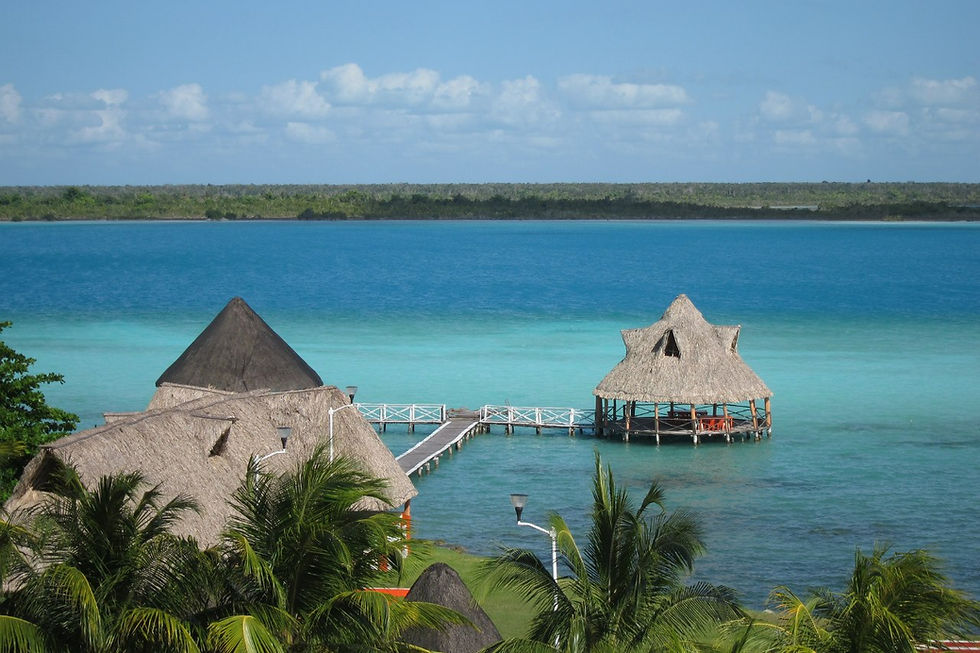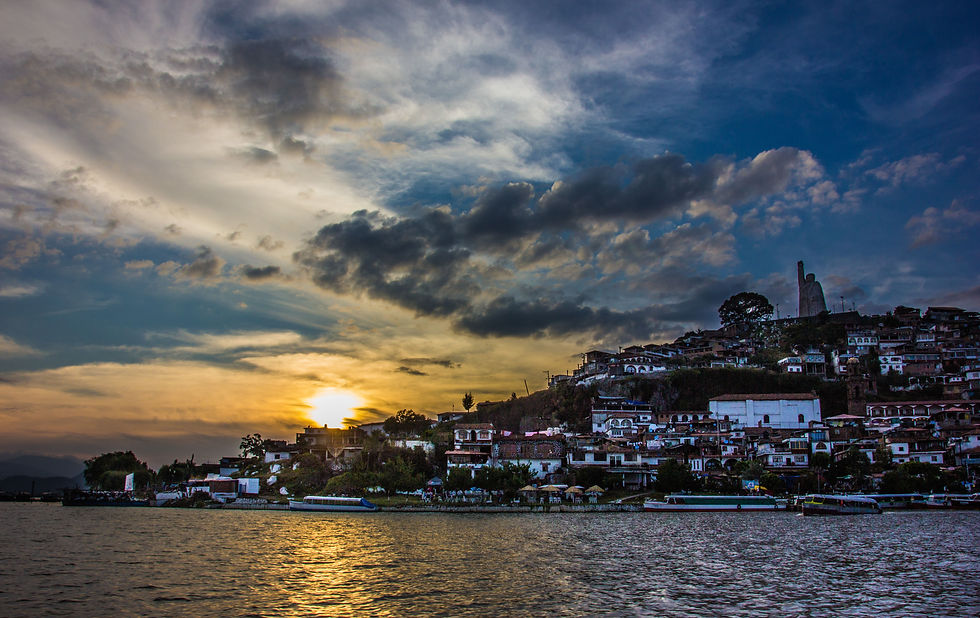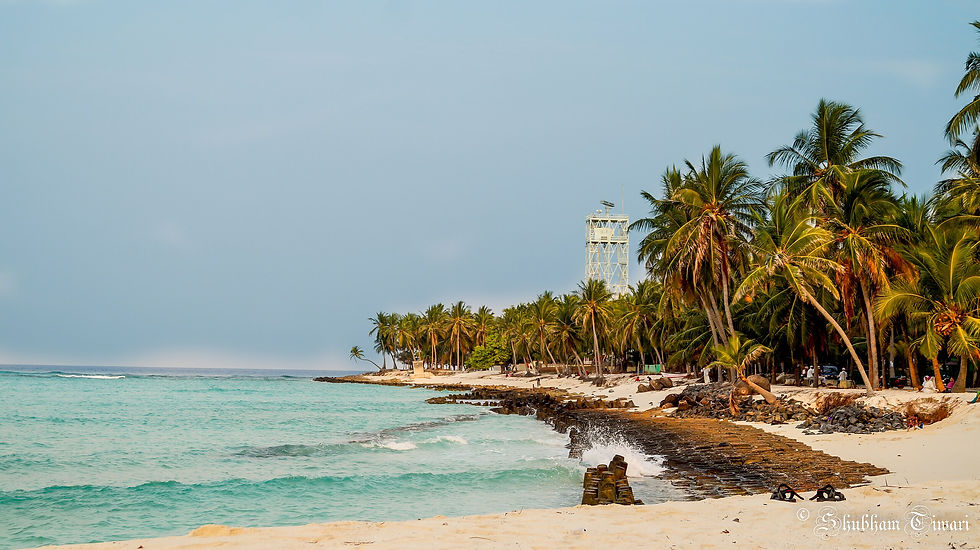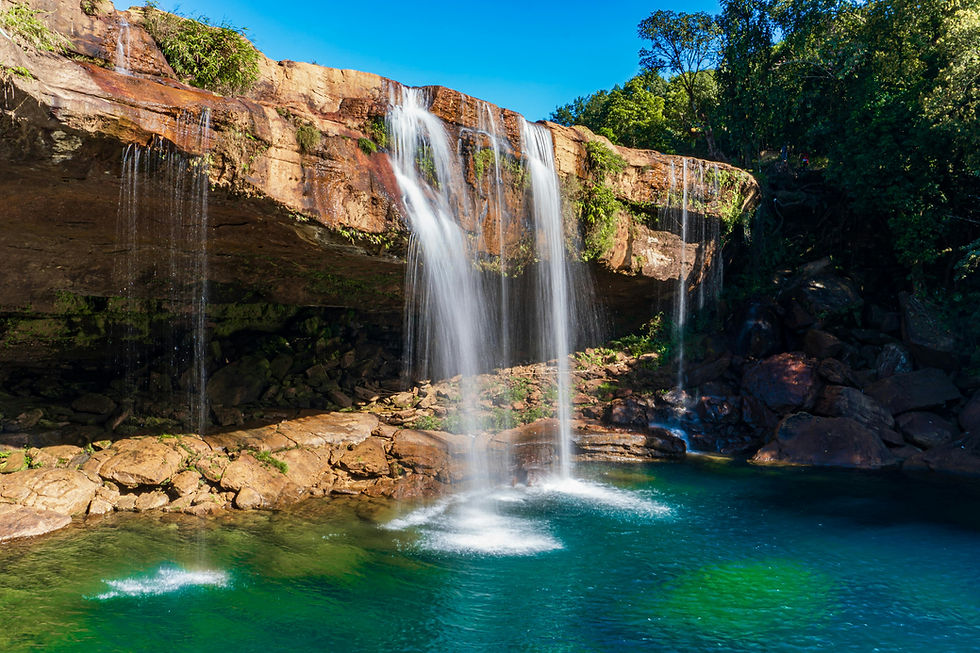10 BEST hidden gems to visit in Mexico in August
- Our Hidden Earth

- Aug 13
- 15 min read
August in Mexico is a month when hidden corners of the country come alive in ways few travellers get to see. Away from the busy resort towns and famous landmarks, there are secluded beaches, vibrant highland towns, and cultural treasures waiting to be explored.
The rainy season breathes life into the landscape, turning hillsides green, rivers full, and gardens into colourful displays of native flowers. The warmth of the people matches the season, making these off-the-beaten-path destinations a joy to discover.
While some might shy away from August due to the occasional rain, those in the know understand that this month is one of Mexico’s most rewarding times for travel. Temperatures remain pleasant in many regions, and showers often pass quickly, leaving behind crisp air and freshly washed streets.
From remote mountain villages to hidden bays along the coast, these destinations offer a mix of culture, nature, and culinary delights. Whether you are seeking tranquillity, adventure, or a little of both, these hidden gems will give you a fresh perspective on Mexico in August.

1) Isla Holbox
Isla Holbox in August is a peaceful island escape where sandy streets and the sound of waves replace the rush of everyday life. Located off the Yucatán Peninsula, it feels far removed from busier coastal hubs.
The warm, shallow waters are ideal for swimming, and the light afternoon rains bring a refreshing change to the tropical air. Sunsets over the Gulf of Mexico are particularly vibrant this time of year, painting the sky in shades of pink, orange, and gold.
August is also the season for whale shark encounters, a rare and unforgettable experience. Local guides offer respectful tours to see these gentle giants in their natural habitat. Flamingos can often be spotted in the shallow lagoons, adding another layer of magic to the island’s natural wonders.
The island’s food scene thrives in August with freshly caught seafood and tropical fruits at their sweetest. Ceviche made from the day’s catch, paired with mango or papaya smoothies, is a simple yet perfect meal. Evening walks along the beach reveal bioluminescent waters on clear nights, turning each step into a sparkle.
Isla Holbox in August offers that rare mix of tranquillity, natural beauty, and unique seasonal wildlife encounters. It’s a place where the days blend gently into one another, and every moment feels unhurried.
FAQs/Things to know before visiting Isla Holbox
1) Is Isla Holbox good to visit in August?
Yes, August is excellent for those who enjoy a relaxed pace and warm, tropical weather. While there may be occasional showers, they are usually short-lived and refreshing. The island is less crowded than in peak season, allowing for peaceful exploration. Seasonal wildlife like whale sharks and flamingos make it even more special.
2) What activities can I do on Isla Holbox in August?
Swimming, paddleboarding, and snorkelling are popular choices. Whale shark tours are a highlight of the season. Birdwatching for flamingos and other coastal species is rewarding. Evening walks may reveal bioluminescent waters.
3) What foods should I try on Isla Holbox in August?
Fresh ceviche is a must-try, made from fish caught that day. Lobster pizza is a local favourite. Tropical fruits like mango and papaya are at their sweetest. Smoothies and fresh juices are perfect for cooling down.
4) Are there festivals on Isla Holbox in August?
While there are no major festivals, local bars and restaurants often host small live music nights. These gatherings create a friendly, community feel. You might also find beachside art markets showcasing local crafts. Such events add charm to your stay.

2) Real de Catorce
High in the mountains of San Luis Potosí, Real de Catorce is a former silver mining town with a mystical charm. In August, the rainy season transforms the surrounding desert hills into green slopes dotted with wildflowers.
The cooler mountain climate is a welcome relief from the summer heat in other parts of Mexico. Cobblestone streets wind past stone houses, and the air feels clean and crisp after light showers.
Walking through the town is like stepping back in time. Abandoned buildings and old mine entrances tell stories of its past wealth and decline. The Templo de la Purísima Concepción, with its striking architecture, stands proudly as a reminder of the town’s spiritual and cultural roots. Local artisans sell handmade goods, from woven textiles to silver jewellery.
August is also a good time to explore the surrounding hills on horseback, a popular way to reach nearby viewpoints. The landscape offers sweeping views that feel both vast and intimate, especially under the soft light after rain. Evenings are cool and perfect for enjoying a hot drink in one of the small cafés.
Real de Catorce in August blends history, natural beauty, and a touch of the mystical. It’s a hidden gem that invites you to slow your steps and soak in the quiet charm of the highlands.
FAQs/Things to know before visiting Real de Catorce
1) Is Real de Catorce worth visiting in August?
Yes, the cooler weather and green landscapes make it an appealing choice. The rain adds freshness to the air and beauty to the surroundings. Tourist numbers are lower compared to winter. The atmosphere is peaceful and reflective.
2) What can I do in Real de Catorce in August?
Explore the historic streets and buildings. Take a horseback ride to scenic viewpoints. Visit the local church and artisan markets. Enjoy the surrounding hills on foot or with a guide.
3) What foods should I try in Real de Catorce in August?
Local stews made with seasonal vegetables are comforting in the cool evenings. Freshly baked bread from local bakeries is delicious. Traditional sweets are sold by street vendors. Hot drinks like atole or coffee are perfect after a walk.
4) Are there festivals in Real de Catorce in August?
August is generally a quieter month, but small community gatherings may occur. These often feature local music and dancing. Religious celebrations sometimes take place in the church. Such events offer a glimpse into local traditions.

3) Bacalar
Bacalar, known as the “Lagoon of Seven Colours,” is a tranquil lakeside town in Quintana Roo that feels worlds away from the crowded beaches of the Caribbean coast. In August, the lagoon’s shades of blue and turquoise seem even more vivid under the bright summer sun.
The warm days invite you to spend hours swimming, kayaking, or simply floating in the calm waters. Afternoon rains refresh the air and add a soft mist over the surrounding greenery.
The town itself is quiet and relaxed, with friendly locals who are happy to share their favourite spots. Wooden piers stretch into the lagoon, offering perfect places for a morning coffee with a view. Small cafés and restaurants serve fresh fish, tropical juices, and simple but flavourful Yucatecan dishes.
August is a great month to explore Bacalar by boat, as the calm waters make for smooth sailing. Tours often include stops at the Pirate’s Channel, a shallow stretch with soft white sand underfoot. The mix of natural beauty and peaceful atmosphere makes it a favourite for those seeking rest and rejuvenation.
Bacalar in August is about slowing down and soaking up the beauty of nature. Whether you’re floating in the lagoon or watching the sunset from a pier, the calm is irresistible.
FAQs/Things to know before visiting Bacalar
1) Is Bacalar crowded in August?
No, Bacalar is generally quieter than more famous beach towns during this month. The atmosphere is peaceful and uncrowded. This makes it ideal for travellers looking for tranquillity. You can enjoy the lagoon without competing for space.
2) What activities are best in Bacalar in August?
Swimming and kayaking are popular on the lagoon. Boat tours to the Pirate’s Channel are a must. Visiting nearby cenotes is refreshing. Sunset watching from a pier is a daily highlight.
3) What foods should I try in Bacalar in August?
Fresh fish dishes are a speciality here. Panuchos and salbutes offer a taste of Yucatecan street food. Tropical fruit juices are cooling and delicious. Many restaurants use local ingredients in creative ways.
4) Are there festivals in Bacalar in August?
Bacalar is more about quiet charm than big festivals in August. However, small community events sometimes take place. Local restaurants may host live music nights. These intimate gatherings are a great way to meet locals.

4) Comala
Comala, in the state of Colima, is a charming “Pueblo Mágico” that thrives on tradition and hospitality. In August, the surrounding volcanic landscapes turn lush with greenery, and the air carries the scent of rain-soaked earth.
The whitewashed buildings and cobblestone streets stand out beautifully against the verdant backdrop. The weather is warm but moderated by the occasional afternoon rain.
This month is perfect for exploring Comala’s central plaza, where you can enjoy traditional “botanas”, small snacks served free with drinks. Local musicians often play in the square, creating a lively but relaxed atmosphere. The nearby Volcán de Fuego can sometimes be seen releasing small puffs of smoke, adding drama to the skyline.
Comala is also known for its coffee production, and August is a wonderful time to visit local plantations. You can learn about the cultivation process and taste freshly roasted beans. For nature lovers, the surrounding countryside offers scenic hikes and birdwatching opportunities.
The town’s welcoming spirit and natural setting make Comala in August a hidden gem worth discovering. It’s a place where time slows down and every interaction feels genuine.
FAQs/Things to know before visiting Comala
1) Is Comala good to visit in August?
Yes, the greenery is at its peak thanks to the rains. The weather is warm but not overly hot. The town feels fresh and vibrant. It’s a great time for both cultural and outdoor activities.
2) What can I do in Comala in August?
Enjoy the central plaza and sample traditional botanas. Visit coffee plantations for tours and tastings. Go hiking in the surrounding countryside. Attend local music performances in the evenings.
3) What foods should I try in Comala in August?
Botanas are a must, especially those featuring local cheese and meats. Freshly brewed coffee is exceptional here. Traditional soups and stews are comforting after a rain shower. Try sweet treats made with tropical fruits.
4) Are there festivals in Comala in August?
While major festivals are held later in the year, local celebrations still occur. These may include music, dance, and food events in the plaza. Coffee-related gatherings sometimes happen. They offer a warm and authentic experience.

5) Huasteca Potosina
Huasteca Potosina, in San Luis Potosí, is a region of waterfalls, rivers, and lush jungle that comes alive in August. The rainy season feeds the waterfalls, making them powerful and dramatic.
The rivers run full and clear, perfect for swimming and rafting. The air is warm and humid, with the scent of wet vegetation all around.
Visiting in August means experiencing this region at its most vibrant. The Tamul Waterfall, one of the tallest in Mexico, is especially breathtaking. The turquoise pools of the Puente de Dios glisten under the sunlight, inviting you in for a dip. Guided boat trips on the Tampaón River reveal stunning rock formations and hidden caves.
Local towns in the region celebrate small community events, and markets offer seasonal fruit and regional specialities. You might try “zacahuil,” a massive tamale wrapped in banana leaves, or fresh river fish cooked simply over a fire. The hospitality in these small towns makes the adventure even more memorable.
Huasteca Potosina in August is a paradise for nature lovers. It’s a place to embrace the elements and be rewarded with unforgettable sights and sounds.
FAQs/Things to know before visiting Huasteca Potosina
1) Is August a good time to visit Huasteca Potosina?
Yes, this is when the waterfalls are at their most powerful. The scenery is lush and vibrant. Warm weather makes swimming comfortable. Occasional rains are part of the experience.
2) What activities can I do in Huasteca Potosina in August?
Visit waterfalls like Tamul and Micos. Swim in the Puente de Dios pools. Take boat trips along the rivers. Explore small towns for local culture and food.
3) What foods should I try in Huasteca Potosina in August?
Zacahuil is a regional highlight. Fresh river fish is widely served. Tropical fruits are abundant and sweet. Street food offers unique local flavours.
4) Are there festivals in Huasteca Potosina in August?
While there are no major festivals, local markets and community events are lively. You may find traditional music and dance in the towns. Seasonal food fairs sometimes take place. They add cultural depth to your visit.

6) Mazunte
Mazunte, a small coastal village in Oaxaca, is known for its relaxed vibe and natural beauty. In August, the Pacific waters are warm and inviting, while the surrounding hills are lush from recent rains.
The village has a bohemian charm, with sandy paths leading to eco-friendly guesthouses and beachside cafés. The sunsets here are fiery and unforgettable, painting the sky in deep oranges and reds.
One of Mazunte’s highlights in August is the abundance of sea turtles. This is nesting season, and guided tours offer a responsible way to witness turtles coming ashore to lay their eggs. The town’s National Mexican Turtle Centre provides education and conservation insight.
The food scene reflects the laid-back lifestyle. Fresh seafood is plentiful, with grilled fish and shrimp tacos being local staples. Smoothies made from mango, pineapple, and passionfruit are refreshing in the heat.
Mazunte in August offers a perfect mix of tranquillity, nature, and community warmth. It’s the kind of place where days are shaped by the tide and nights by the stars.
FAQs/Things to know before visiting Mazunte
1) Is Mazunte worth visiting in August?
Yes, the beaches are quiet, and the warm waters are ideal for swimming. The sea turtle nesting season adds a unique wildlife experience. Rain showers are brief and refreshing. The atmosphere is calm and welcoming.
2) What activities can I do in Mazunte in August?
Relax on the beach or swim in the ocean. Take guided turtle tours to see nesting events. Visit the Turtle Centre for conservation education. Hike nearby trails for coastal views.
3) What foods should I try in Mazunte in August?
Grilled fish tacos are a must. Shrimp dishes are fresh and flavourful. Tropical smoothies are perfect for hot afternoons. Many cafés also offer vegetarian and organic options.
4) Are there festivals in Mazunte in August?
While the main turtle festival happens later in the year, August still has conservation-focused events. Local gatherings may feature music and dance. Beach bonfires sometimes bring the community together. These moments make the stay memorable.

7) Valle de Bravo
Valle de Bravo, in the State of Mexico, is a lakeside town surrounded by forested hills. August brings cooler temperatures and lush greenery, making it an excellent escape from the heat of the cities.
The lake shimmers under cloudy skies, and the air smells fresh after light rain. It’s a popular spot for water sports, but still maintains a calm atmosphere in this season.
Boating on the lake is a favourite activity, with plenty of opportunities to kayak, sail, or paddleboard. Hiking trails in the surrounding hills lead to scenic viewpoints. Paragliding is also popular here, offering sweeping views of the town and lake.
The historic centre is filled with cobblestone streets, artisan shops, and cosy cafés. Local markets offer fresh produce, baked goods, and handmade crafts. August is also a good month to try traditional dishes like trout from the lake or “garnachas” topped with salsa and cheese.
Valle de Bravo in August is a refreshing blend of adventure and relaxation. It’s a place where you can balance active days with peaceful evenings.
FAQs/Things to know before visiting Valle de Bravo
1) Is August a good month for Valle de Bravo?
Yes, the weather is cooler and the scenery is green and vibrant. The lake is perfect for water activities. Crowds are smaller compared to holiday seasons. Afternoon rains are brief and add freshness.
2) What activities can I enjoy in Valle de Bravo in August?
Try boating, kayaking, or sailing on the lake. Go hiking in the surrounding hills. Visit the town centre for shopping and dining. Paragliding offers stunning views.
3) What foods should I try in Valle de Bravo in August?
Fresh trout is a local speciality. Garnachas are a tasty street food option. Pastries from local bakeries are delicious. Seasonal fruit is abundant and sweet.
4) Are there festivals in Valle de Bravo in August?
While August is quieter, occasional cultural events take place. These may include music performances in the plaza. Artisan fairs sometimes occur. They add a charming local touch to your visit.

8) Pátzcuaro
Pátzcuaro, in Michoacán, is a colonial town with deep indigenous roots. In August, the surrounding countryside is lush, and the town’s red-tiled roofs glisten under gentle rain. The cooler temperatures make walking through its historic streets a pleasure.
The main plaza is lined with trees and surrounded by centuries-old buildings.
Lake Pátzcuaro is the heart of the area, and boat trips to nearby islands reveal unique traditions. Isla de Janitzio is especially famous for its indigenous culture and crafts. The markets are lively with fresh produce, flowers, and handmade textiles.
Local cuisine in August features hearty soups, tamales, and dishes made with seasonal vegetables. Sweet bread from local bakeries pairs perfectly with hot chocolate on cooler evenings. Street musicians often provide a gentle soundtrack to your wanderings.
Pátzcuaro in August offers a slower pace and a deeper connection to tradition. It’s a place to experience Mexico’s cultural heritage in an intimate setting.
FAQs/Things to know before visiting Pátzcuaro
1) Is Pátzcuaro good to visit in August?
Yes, the cool weather and lush scenery make it enjoyable. Rain showers are brief and add to the charm. The town feels authentic and welcoming. Crowds are minimal this time of year.
2) What can I do in Pátzcuaro in August?
Explore the historic centre and main plaza. Take boat trips to the lake’s islands. Shop for crafts in the markets. Visit local museums for cultural insights.
3) What foods should I try in Pátzcuaro in August?
Tamales are a local staple. Try traditional soups made with seasonal vegetables. Sweet bread is perfect for evenings. Local cheeses are also worth sampling.
4) Are there festivals in Pátzcuaro in August?
August is a quieter month, but local markets sometimes host small events. Music performances in the plaza are common. Artisan fairs may also occur. These add to the community atmosphere.

9) Xilitla
Xilitla, in San Luis Potosí, is a surreal mix of jungle and art. August brings warm, humid air and abundant rain, which keeps the surrounding vegetation thick and vibrant.
The town is famous for Las Pozas, the whimsical garden of English artist Edward James, filled with surreal concrete sculptures. The site feels even more magical under a soft drizzle.
The surrounding Huasteca region offers waterfalls, caves, and rivers to explore. Hiking here in August is rewarding, as the landscapes are at their greenest. The sound of rushing water is a constant background. Local guides can lead you to hidden spots off the usual tourist trails.
In town, small cafés and markets serve regional dishes. Fresh tropical fruit is abundant, and coffee from nearby plantations is rich and aromatic. The relaxed pace encourages you to linger over meals.
Xilitla in August is a feast for the senses. It combines natural beauty, artistic wonder, and small-town charm into a unique experience.
FAQs/Things to know before visiting Xilitla
1) Is Xilitla worth visiting in August?
Yes, the lush scenery and cooler temperatures make it ideal. Rain adds to the jungle’s beauty. Crowds are smaller, offering a more intimate visit. Las Pozas is particularly atmospheric this time of year.
2) What activities can I do in Xilitla in August?
Visit Las Pozas for art and nature. Explore waterfalls and caves in the region. Hike jungle trails with local guides. Enjoy fresh coffee in small cafés.
3) What foods should I try in Xilitla in August?
Regional stews are warming after rain. Fresh tropical fruits are in season. Locally grown coffee is excellent. Street vendors often sell sweet treats.
4) Are there festivals in Xilitla in August?
While August is quieter, community events still occur. Music and dance performances may take place in the plaza. Artisan markets are common. These small gatherings feel authentic and friendly.

10) Tlacotalpan
Tlacotalpan, in Veracruz, is a colourful riverside town with a rich cultural heritage. August brings warm, humid weather and occasional showers, which make the pastel façades look freshly painted.
The town’s location on the Papaloapan River gives it a breezy charm.
The historic centre is a UNESCO World Heritage site, with wide streets and colonial-era buildings.
Walking along the riverfront is especially pleasant in the cooler mornings. Small boats offer rides along the river, giving you a new perspective on the town.
Local cuisine focuses on river fish, seafood, and tropical fruits. Markets are lively with vendors selling everything from plantains to tamales. Traditional music often drifts from doorways, adding to the relaxed atmosphere.
Tlacotalpan in August feels like stepping into a painting. It’s vibrant, musical, and full of life, even during quiet moments.
FAQs/Things to know before visiting Tlacotalpan
1) Is Tlacotalpan good to visit in August?
Yes, the warm weather and lively markets make it enjoyable. Showers are short and keep the air fresh. The town’s colourful charm is at its best. River breezes make it comfortable.
2) What can I do in Tlacotalpan in August?
Walk through the historic centre. Take boat rides on the river. Visit local markets for food and crafts. Listen to traditional music in the evenings.
3) What foods should I try in Tlacotalpan in August?
River fish dishes are a speciality. Plantains are used in both sweet and savoury recipes. Tamales are a local favourite. Tropical fruit juices are refreshing.
4) Are there festivals in Tlacotalpan in August?
August is quieter than festival season, but small cultural events occur. Music gatherings are common. Artisan markets pop up in the plaza. These events are welcoming and relaxed.

Mexico in August is full of hidden treasures for those willing to explore beyond the main tourist paths. The rainy season enhances the country’s natural beauty, from the turquoise lagoons of Bacalar to the green highlands of Pátzcuaro. Smaller towns and remote regions offer a slower pace, authentic cultural experiences, and warm hospitality.
Visiting these hidden gems in August also means enjoying fewer crowds and more intimate moments with the places you discover. Whether it’s spotting nesting turtles in Mazunte, swimming under waterfalls in Huasteca Potosina, or sipping coffee in a quiet Comala café, each destination offers something unique.
If you’re looking for an August getaway that combines adventure with relaxation, Mexico’s lesser-known spots are waiting to welcome you. These are the places where you can truly connect with the heart of the country and create lasting memories.
When exploring these hidden gems, always consider hiring a guide or joining a tour group, as some locations may require local expertise for the best experience.
Did you know we have a Hidden Gem Finder on our website? This handy little map shows over 13,000 hidden gems across the entire world with their exact co-ordinates available to view on Google Maps as well as an image/description for each one!












Comments